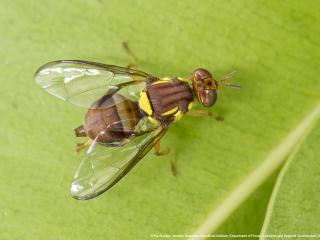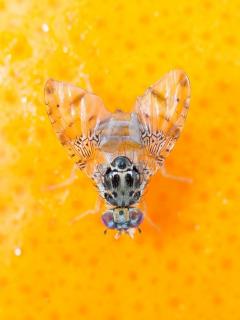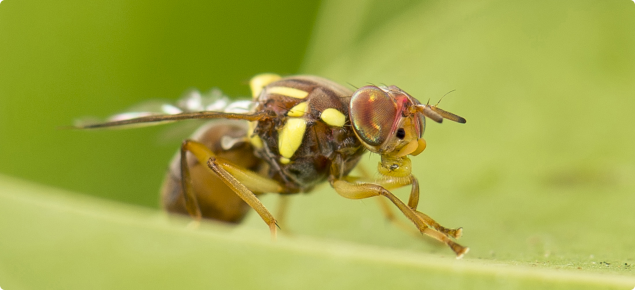Qfly is an Australian fruit fly native to the tropical and subtropical rainforests of Queensland and northern New South Wales. Over time, the clearance of forests for cultivation of fruits and fruiting vegetables and the introduction of exotic fruits has resulted in Qfly increasing its host range and distribution into urban and horticultural areas in Queensland, New South Wales, Victoria and the Northern Territory.
The expansion of irrigated agriculture and proliferation of backyard gardens has also allowed Qfly to spread into drier and cooler areas outside its native habitat.
Outbreaks are most likely to occur from November to May after periods of rain or high humidity, but some activity may continue during cooler months of the year.
Western Australia, South Australia and Tasmania are free of Qfly.
Agricultural and economic impact
Qfly is considered a serious horticultural pest because it is highly invasive, infesting more than 300 species of cultivated fruits and vegetables.
Economic losses are estimated at $300 million which includes control and loss of production, postharvest treatments, on‐going surveillance for area freedom and loss or limit to domestic and international markets.
Symptoms of damage
Damage occurs as the larvae develop and feed from within fruit. Adult female flies sting fruit and fruiting vegetables to lay eggs. This introduces bacteria and the fruit starts to rot. Affected fruit may show skin discolouration around the sting marks; fruit decompose rapidly, inducing decay and early fruit drop.
Qfly damage to fruit is more severe during mid and late summer than at other times.
Description
| Adult
| The body has three segments and is about 6-8 mm long. The head has two red eyes with two very short antennae (only visible under close inspection). The thorax (middle segment) is reddish-brown with yellow patches on the sides and back. The abdomen (end segment) is a solid dark brown. The legs are a lighter shade of brown and the wings are clear. |
| Eggs | White 1mm banana-shaped eggs. |
| Maggot (larva) | Cream-coloured maggots hatch from each egg, reaching about 7mm long when mature. |
| Pupa | Mature larvae change into an oval, brown hard pupa. |
Life cycle
Eggs: female lays eggs just under the surface of the fruit. One QFF can lay up to 100 eggs a day.
Larvae: the maggots or larvae hatch from the egg after two to three days and start feeding on the fruit. Larvae quickly grow from 1mm to 1cm long when mature.
Pupa: the fully grown larva jumps from the fruit and drops to the ground tunneling into the soil. In the soil, larvae become inactive and changes into a barrel-shaped pupa.
Adult: the adult QFF emerges from the ground. After feeding and mating, females search for suitable ripe fruit to lay their eggs inside, restarting the cycle.
The life cycle is more rapid when temperatures are high. In summer, Qfly can develop from egg to adult in three weeks. Adult flies can live for months.
Qfly or Medfly?
Don't confuse Qfly for Mediterranean fruit fly (Medfly).


The eggs and larvae of Qfly and Medfly look identical and cannot be easily distinguished from one another. Refer to the fly ID guide on the right hand side of this web page or the Medfly web pages for more identifying information.
Report fruit fly to us
Samples or photos of adult flies caught in fruit fly traps or photographed on the fruit can be submitted for identification and screening. The presence of white larvae in green tomatoes, unripe fruit, and passionfruit is worth reporting so we can screen for Qfly as Medfly larvae are not often found in these.
Please take photos where ever possible and report to:
| MyPestGuide™ Reporter | Pest and Disease Information Service (PaDIS) |



